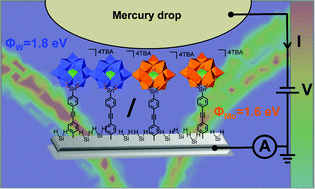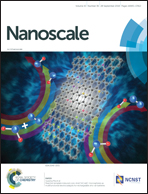Molecular signature of polyoxometalates in electron transport of silicon-based molecular junctions†
Abstract
Polyoxometalates (POMs) are unconventional electro-active molecules with a great potential for applications in molecular memories, providing efficient processing steps onto electrodes are available. The synthesis of the organic–inorganic polyoxometalate hybrids [PM11O39{Sn(C6H4)C![[triple bond, length as m-dash]](https://www.rsc.org/images/entities/char_e002.gif) C(C6H4)N2}]3− (M = Mo, W) endowed with a remote diazonium function is reported together with their covalent immobilization onto hydrogenated n-Si(100) substrates. Electron transport measurements through the resulting densely-packed monolayers contacted with a mercury drop as a top electrode confirms their homogeneity. Adjustment of the current–voltage curves with the Simmon's equation gives a mean tunnel energy barrier ΦPOM of 1.8 eV and 1.6 eV, for the Silicon–Molecules–Metal (SMM) junctions based on the polyoxotungstates (M = W) and polyoxomolybdates (M = Mo), respectively. This follows the trend observed in the electrochemical properties of POMs in solution, the polyoxomolybdates being easier to reduce than the polyoxotungstates, in agreement with lowest unoccupied molecular orbitals (LUMOs) of lower energy. The molecular signature of the POMs is thus clearly identifiable in the solid-state electrical properties and the unmatched diversity of POM molecular and electronic structures should offer a great modularity.
C(C6H4)N2}]3− (M = Mo, W) endowed with a remote diazonium function is reported together with their covalent immobilization onto hydrogenated n-Si(100) substrates. Electron transport measurements through the resulting densely-packed monolayers contacted with a mercury drop as a top electrode confirms their homogeneity. Adjustment of the current–voltage curves with the Simmon's equation gives a mean tunnel energy barrier ΦPOM of 1.8 eV and 1.6 eV, for the Silicon–Molecules–Metal (SMM) junctions based on the polyoxotungstates (M = W) and polyoxomolybdates (M = Mo), respectively. This follows the trend observed in the electrochemical properties of POMs in solution, the polyoxomolybdates being easier to reduce than the polyoxotungstates, in agreement with lowest unoccupied molecular orbitals (LUMOs) of lower energy. The molecular signature of the POMs is thus clearly identifiable in the solid-state electrical properties and the unmatched diversity of POM molecular and electronic structures should offer a great modularity.



 Please wait while we load your content...
Please wait while we load your content...